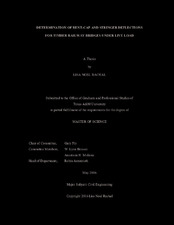| dc.description.abstract | Many aging timber railroad bridges are currently in use throughout the United States, and these bridges are being exposed to increasingly heavy loads from rolling stock and other harsh conditions. This could lead to flexural failure or horizontal shear cracking of the stringers, which could result in a split stringer. The maximum flexural stress in a split stringer is two times larger than that of an unimpaired stringer when exposed to the same load. This thesis outlines the instrumentation and analysis of a small-scale timber bridge model and two large-scale bridges in order to better understand a timber railroad bridge’s response to a live load. String potentiometers were used to measure bent-cap and stringer deflections, and wheel path position sensors were created and installed in order to determine vehicle speed and position as it traversed the bridge. Each test included different experimental parameters, such as different vehicle speeds and vehicle types.
During the course of each experiment, the bent-caps experienced very little deflection when under live load. It was also determined that vehicle speed did not significantly affect bent-cap deflection, total stringer mid-span deflection, or net stringer mid-span deflection. In the past, it has been assumed that stringers comprising a chord acted as one member. However, the results of this research demonstrated that each stringer in a chord experienced extremely different deflections in response to a vehicle traversing the bridge. This research also demonstrated a significant difference between the magnitude of the maximum total mid-span stringer deflections and the maximum net mid-span stringer deflections. The total mid-span stringer deflections were anywhere from 36% to 80% higher than the net deflections. It was also concluded that the maximum mid-span stringer deflection that occurred as a freight train traversed a bridge were due to the trucks that were on each side of the couplings connecting the rolling stock. In addition, the mid-span deflections of a split stringer were found to be four times larger than that of an unimpaired stringer when exposed to the same live load. | en |


